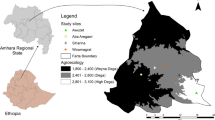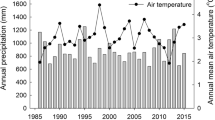Abstract
Key message
The Eucalyptus productivity increase was mainly caused by the increased proportion of newly planted areas for Eucalyptus afforestation and the decreasing area of original Eucalyptus plantations.
Abstract
Eucalyptus tree is a major fast-growing species in South China. The ecological problems associated with quickly developing Eucalyptus plantations have been a focus of extensive debate. In this study, we used spatial analysis and geostatistical methods along with field survey data from four successive National Forest Inventories (NFI's) as well as terrain and meteorological data to analyze dynamics of the Eucalyptus plantation distribution in China. The Eucalyptus productivity levels were compared among the four inventories by measuring annual mean productivity in permanent sample plots to provide a basic description of Eucalyptus plantations. Results showed that the area of Eucalyptus plantations increased constantly in China, expanding from 60.7 × 104 ha in the 5th inventory to more than 445.5 × 104 ha in the 8th inventory. However, these changes did not necessarily indicate an improvement in the management quality of Eucalyptus plantations, since they were mainly caused by an increase in the proportion of newly planted Eucalyptus areas and the decrease of the original Eucalyptus plantation area. The productivity of Eucalyptus plantations was significantly positively correlated with temperature and rainfall, but negatively correlated with elevation.






Similar content being viewed by others
References
Asner GP, Powell GVN, Joseph M et al (2010) High-resolution forest carbon stocks and emissions in the Amazon. Proc Natl Acad Sci USA 107:16738–16742
Berenguer HDP, Alves A, Amaral J et al (2018) Differential physiological performance of two Eucalyptus species and one hybrid under different imposed water availability scenarios. Trees-Struct Funct 32:415–427
Carignato A, Vázquez-Piqué J, Tapias R et al (2020) Variability and plasticity in cuticular transpiration and leaf permeability allow differentiation of Eucalyptus clones at an early age. Forests 11:9
Chen W, Jiang HZ, Moriya K et al (2018) Monitoring of post-fire forest regeneration under different restoration treatments based on ALOS/PALSAR data. New for 49:105–121
Fu X, Wang XJ, Han AH et al (2008) Dynamic monitoring and analysis of eucalyptus resources in pulp origin place based on remote sensing. J Beijing for Univ 30:89–93
Gama FF, Dos Santos JR, Mura JC et al (2010) Eucalyptus biomass and volume estimation using interferometric and polarimetric SAR data. Remote Sens 2:939–956
Hou YZ (2006) Understanding scientifically the issue of developing fast-growing and high-yielding Eucalypt plantation in South China. World for Res 19:71–76
Jean MC, John P, Eckehard B et al (2006) Planted Forests and Bio-diversity. J for 104:65–77
John JW (2002) Eucalyptus: the genus Eucalyptus. Copper London & New York, pp 1–10
Kong HM, Wei LL, Liu GH (2010) Application of Kriging method in the study on spatial patterns of plant species geographical distribution. Ecol Environ Sci 19:1165–1169
Kumbula ST, Mafongoya P, Peerbhay KY et al (2019) Using sentinel-2 multispectral images to map the occurrence of the Cossid moth (Coryphodema tristis) in eucalyptus nitens plantations of Mpumalanga, South Africa. Remote Sens 11:278
Lei XD, Tang MP, Lu YC et al (2009) Forest inventory in China: status and challenges. Int for Rev 11:52–63
Liu JF (2009) Present Status and Trends in Development of Eucalypt Research in China. Eucalypt Technology 26:50–62
Mhiret DA, Dagnew DC, Alemie TC et al (2019) Impact of soil conservation and eucalyptus on hydrology and soil loss in the Ethiopian Highlands. Water 11:2299
Peuke AD, Merchant A (2019) Diagnostic tools for nutrition status in Eucalyptus globulus: changes in leaves, xylem and phloem sap compounds according to N-, P-, and K-withdrawal or salt application. Trees-Struct Funct 33:443–456
Qian GQ (2007) Ecological problem and development countermeasure of Eucalyptus. Hunan for Sci Technol 34:67–70
Reis MG, Ribeiro A, Alves EEN et al (2019) Maximum CO2 assimilation in young Eucalyptus plantations is higher than in Brazilian savanna trees during dry field seasons. Trees-Struct Funct 33:543–556
Shang X, Arnold RJ, Wu Z et al (2019) Combining quantitative data on growth, wood density and other traits with SSR markers to evaluate genetic diversity and structure in a planted population of Eucalyptus camaldulensis Dehn. Forests 10:1090
Silva CA, Klauberg C, Chaves DP et al (2014) Mapping above ground carbon stocks using LiDAR data in Eucalyptus spp. plantations in the state of São Paulo, Brazil. Sci For/For Sci 42:591–604
Wang XC, Han SJ, Zou CJ et al (2002) Geostatistical analysis of the pattern of Betula ermanii population in Changbai Mountain. Chin J Appl Ecol 13:781–784
Wang Z, Du A, Xu Y et al (2019) Factors limiting the growth of eucalyptus and the characteristics of growth and water use under water and fertilizer management in the dry season of Leizhou Peninsula, China. Agronomy 9:590
Xie YJ (2003) Primary studies on sustainable management strategy of eucalyptus plantation in China. World for Res 16:59–64
Xie ZX, Yan DB (2006) Situation of eucalypt plantation and sustainable development. J Sichuan for Sci Technol 27:75–82
Xu DP, Zhang NN (2006) Research progress of Eucalypt plantation ecological effect. Guangxi for Sci 35:179–201
Yao RL, Chen JB (2009) Introduction and protective situation of Eucalypt in China. Guangxi for Sci 38:92–94
Zeng WS, Tomppo E, Healey SP et al (2015) The national forest inventory in China: history-results-international context. For Ecosyst 2:288–303
Zhang NN, Xu DP, Jim M et al (2003) Characteristics of sap flow in Eucalyptus urophylla Plantations on the Leizhou Peninsula. For Res 16:661–667
Zheng S, Shan J, Singh RP et al (2020) High spatio-temporal heterogeneity of carbon footprints in the Zhejiang Province, China, from 2005 to 2015: implications for climate change policies. Environ Chem Lett 18:931–939
Acknowledgements
The National Forestry and Grassland Administration were thanked for providing the geographical locations of Eucalyptus plantations.
Funding
This research was supported by the National Natural Science Foundation of China (No. 41601368 and 41861144026).
Author information
Authors and Affiliations
Corresponding author
Ethics declarations
Conflict of interest
The authors declare that they have no conflict of interest.
Additional information
Communicated by Des Rochers.
Publisher's Note
Springer Nature remains neutral with regard to jurisdictional claims in published maps and institutional affiliations.
Rights and permissions
About this article
Cite this article
Chen, W., Zou, Y., Dang, Y. et al. Spatial distribution and dynamic change monitoring of Eucalyptus plantations in China during 1994–2013. Trees 36, 405–414 (2022). https://doi.org/10.1007/s00468-021-02215-7
Received:
Accepted:
Published:
Issue Date:
DOI: https://doi.org/10.1007/s00468-021-02215-7




